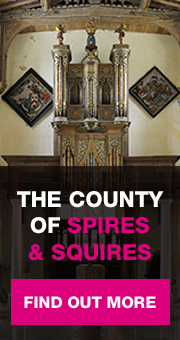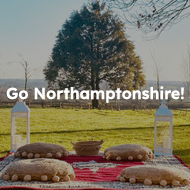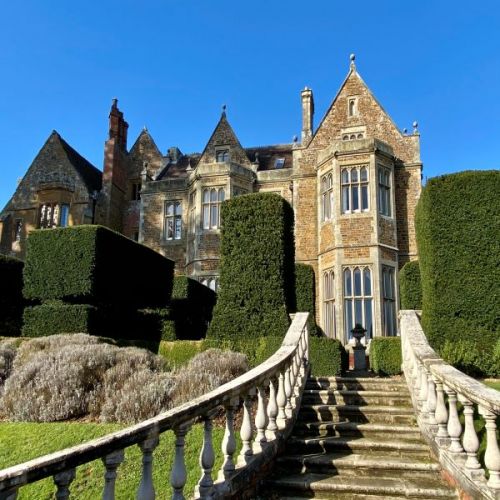23rd December 2020
Travelling to Fawsley Hall is like journeying back in time. Leaving modern roads, one encounters a timeless rural landscape, with farm buildings and fields full of stock animals. The single-track lanes lead past large pools edged with ancient trees. One is more likely to encounter an equestrian than another vehicle. And then silhouetted against the rolling sky, lies Fawsley Hall, a remarkable survivor of changing fortune over the last millennium.
The settlement of Fawsley is known to predate the building of the hall by at least 1000 years. Burials dating back to the 6th Century suggest an established settlement in the locality. The area was recorded as being an Anglo-Saxon Royal Manor, used as an administrative centre, and favoured for hunting. By the time of the Domesday book in 1086 the population was numbered at 50, and the village seems to have grown rapidly until the arrival of the Black Death which claimed the lives of nearly half of the villagers. The remains of the medieval settlement are found in the fields surrounding the charming St Mary’s church, which sits in the deer park belonging to the Hall.
In 1416 the Manor of Fawsley was bought by ambitious Richard Knightley, a successful Staffordshire lawyer. What few villagers were left after the ravages of the plague were soon discouraged, as the Knightley family cleared their land of peasants to enable the profitable business of sheep farming. With their income assured, the family set about building their mansion in the Tudor style surrounding a Great Hall. Subsequent generations of Knightley's acted as Royal servants and in local Government as Sheriffs of Northamptonshire. Edmund was knighted by Henry VIII in 1542, and as Commissioner supervised the confiscation of monastic lands after the Dissolution of the Monasteries. This was a highly lucrative job and enabled the continued building and beautification of the Hall.
It was during this time that the spectacularly beautiful bay window in the Great Hall was constructed opposite the equally handsome fireplace. This hexagonal shaped tower stands proud of the rest of the high roofed hall and is decorated spectacularly both inside and out.
This bay holds secrets! At the very top there is an inaccessible room reaching above the eaves of the roof. It is thought that this may be where secret meetings were held, and certainly there were secrets to be kept in those troubled times. Inside the bay’s ceiling above the seating area, is carved an unmissably large rose. This may have been understood to mean that things discussed here were to be kept secret. Today the term ‘sub rosa’ or ‘under the rose’ still carries a similar meaning, off the record, or confidential.
Discretion was an important quality for successful courtiers, and Sir Richard was honoured to receive Queen Elizabeth I at Fawsley, where she stayed the night. This was a great honour, as well as a great expense, and subsequently knighthoods were bestowed upon the Knightley sons.
However, the family had principles that they believed in strongly. Sir Richard was later imprisoned for printing and distributing Puritan literature, and later the Knightley's supported Parliament against the King during the Civil Wars.
Fawsley Hall saw another phase of building during the Georgian period. Lucy Knightley had inherited in 1728 and added a new wing in the fashionable Classical style, but the glory of this period was the work done by Capability Brown to model the parkland. Glorious vistas studded with specimen trees, the laying of sweeping lawns, and the channelling of streams into lakes, ponds and canals enhanced the setting of the Hall, and is still to be enjoyed today.
In 1798 the family was honoured with a Baronetcy and the second Baronet Sir Charles set about the Hall making Gothic alterations to the Georgian wing. His son Sir Rainald, raised to the Peerage by Queen Victoria, also remodelled the north wing. His wife Louisa was lady in waiting to HRH Duchess of Albany, the wife of Queen Victoria’s youngest son, but sadly this fashionable couple living in the highest of society marked the last high point of the Knightley dynasty, and the beginning of the decline of Fawsley Hall. The couple died with no children, and after the estate passed in turn to each of Sir Rainald’s two brothers, who also died without heirs, the titles, land and Fawsley Hall passed out of the Knightley’s ownership to distant family related only by marriage. This family already possessed fine houses, so Fawsley Hall was neglected.
By the 20th century, like many other great houses, the costs of maintenance necessitated selling off the contents, and 1914 saw both an auction and then requisitioning by the Army at the start of the Great War. The decline of the Hall was hastened with another military requisition during the Second World War, and afterwards suffered an ignominious fall from grandeur when it was subsequently used as a workshop for a timber company. Shabby and dilapidated, Fawsley Hall was even featured in a V & A exhibition on ‘The Decline of the English Country House’.
But rescue was at hand! Mr and Mrs E A Saunders, entrepreneurial antique dealers, recognised the potential of Fawsley, bought the Hall and began the restoration. They later joined together with a consortium to continue investing and developing the Hall into a luxury hotel and spa, to be enjoyed by guests in the 21st century, just as in the 16th century.
Today, keeping these places both solvent and relevant to society is a tough task. Writing as a former manager of nearby Canons Ashby, I can assure you that it takes a great deal of effort. However, I thoroughly approve of us ‘common folk’ being able to enjoy the hospitality of the wonderful historic houses of Northamptonshire. They were built with the sweat of our ancestors for only a privileged few to enjoy at the time. It seems right to me that we should all be able to enjoy them today. We too can dine on fine food, and sleep in a bedchamber where Queen Elizabeth I once slept. We can enjoy a fabulous afternoon tea in a Great Hall where state secrets were spoken of ‘sub rosa’. In these strange uncertain COVID times, a gift certificate for a future treat at Fawsley Hall would be a marvellous Christmas gift. (and I’m hoping my husband is reading this…) Merry Christmas everyone!
For more information, please visit www.handpickedhotels.co.uk/fawsleyhall
Laura Malpas
Your login details have been used by another user or machine. Login details can only be used once at any one time so you have therefore automatically been logged out. Please contact your sites administrator if you believe this other user or machine has unauthorised access.








